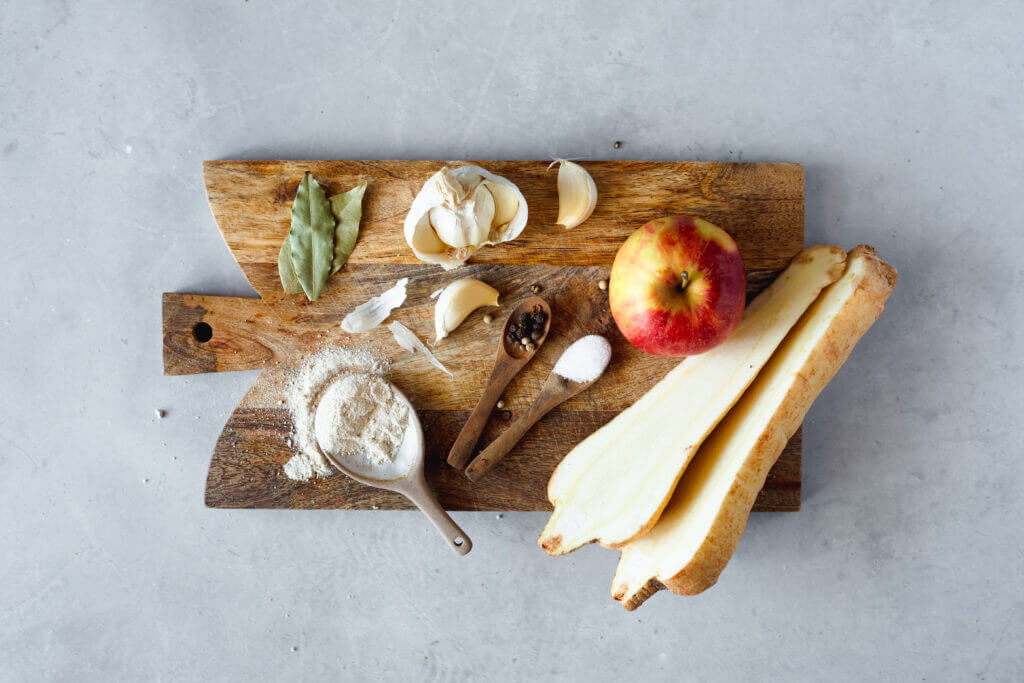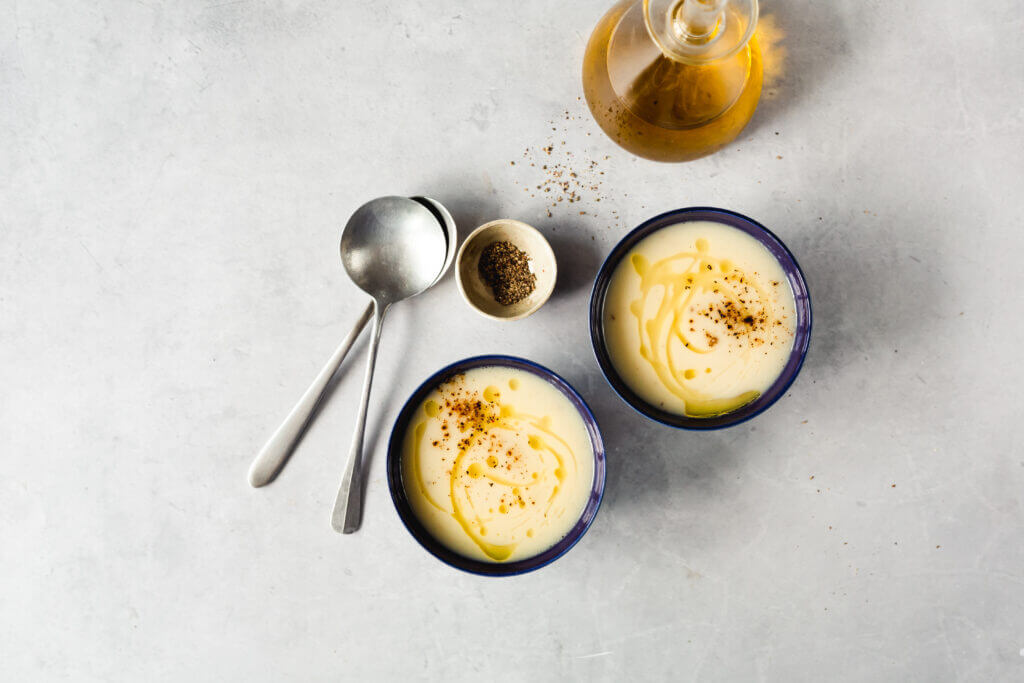Jerusalem artichoke soup recipe
- 2

undefined 5'

undefined 25'

undefined

undefined
- 2

undefined 5'

undefined 25'

undefined

undefined
I don’t even know what a Jerusalem artichoke is
Ah, the peculiar Jerusalem artichoke: its name rings with mystic poetry and pale limestone, its appearance recalls hearty soup cooked over a mediaeval hearth - a romantic image, isn’t it? Well, it’s only half right. Yes, the Jerusalem artichoke makes a creamy, warming soup that’s going to make you want to wrap yourself in a cosy blanket, with a bowl of Jerusalem artichoke soup, and sit in front of a crackling fire. No doubt about that. But don’t be deterred by the Jerusalem artichoke’s imposing name. This gnarly little guy is actually a sunchoke, which means, for one thing, the Jerusalem artichoke doesn’t taste like an artichoke. They are instead mild and sweet, with a flavour and texture often compared to a hazelnut, a water chestnut, or as one self-ordained Foodaholic on Quora puts it, “the best potato you’ve ever had.” The Jerusalem artichoke’s sunchoke status also means you aren’t waging battle with the spiky, green armour that protects a standard artichoke when you go to make your Jerusalem artichoke soup. A Jerusalem artichoke is simply the knob at the base of a certain kind of sunflower (Helianthus tuberosus to be exact): a tuber that balloons underground at the end of the Jerusalem artichoke plant’s roots. In a supermarket, it can easily be mistaken for ginger. The “Jerusalem” in Jerusalem artichoke is the etymological outcome of a long-running game of telephone that began with the Italian word for sunflower, girasole. One day, long ago, someone Italian gave their non-Italian friend a bowl of Jerusalem artichoke soup (probably), and told them it was “girasole” soup. The friend heard “girasolm”, and told her aunt, who heard “jerasolm”...you get the gist. 
I still don’t want to peel Jerusalem artichokes
Feeling better about the sunchoke and ready to try it? Well, with our Jerusalem artichoke soup recipe below, you won’t even have to deal with the prep: a few teaspoons of our Organic Jerusalem Artichoke Powder, and you’re good to go. We source our Jerusalem artichokes from small organic farms in Eastern Europe. Our farmers pick them at the height of the harvest season and dry over the next two days. Then, we grind the dried tubers into powder. That’s five kilos of Jerusalem artichokes for every one kilo of powder! The powder is great to have on hand after you make your Jerusalem artichoke soup. It’s high in prebiotic inulin, which means the Jerusalem artichoke powder is great for your gut AND as a thickener in recipes - we use it in pancakes, muffins, and instead of flour when thickening sauces, like a roux. You are getting all of the benefits in your Jerusalem artichoke soup with none of the work. Remember earlier how that Quora user said a Jerusalem artichoke is like the best potato you’ve ever had? Well, a potato is to starch, as a Jerusalem artichoke is to inulin.
Okay cool, so what’s inulin?
I’m glad you asked. You may not know it, but you’ve probably been eating inulin for a long time. You can find inulin not only in sunchokes, but also as the primary carbohydrate in some of the oldest ingredients in human history. For example, inulin is in garlic, onions, and barley in the West, yacon in South America and Japan, and murnong in Australia. We’ve been eating inulin since the beginning of human existence, and you should continue the tradition. Much like Jerusalem artichoke powder can be used as a thickener in recipes, so too is inulin utilised for its tendency to form a fat-imitating gel that doesn’t fall apart in water. This gel looks a lot like partly-solid coconut oil. Now, imagine this gel in your gut. It passes through your oesophagus, your stomach, your small intestine, and most of your large intestine before arriving at your colon, intact. All the while, it’s helping usher food through your digestive system and adding weight to your stool. This makes it easier to pass. Don’t worry - just because WE can’t digest the inulin doesn’t mean no one is getting to enjoy it. Enter the probiotic bacteria - a.k.a. the “friendly” bacteria living in your gut rent-free that everyone always seems to be talking about. A probiotic, meaning “for life”, is any microorganism in the body that benefits your health. Probiotics inhibit the growth of and can even kill harmful bacteria, jumpstart immune responses, and create protective barriers inside the body. After it reaches the colon, intact, inulin feeds the probiotic bacteria in your body. We can’t digest inulin, but probiotics can. That’s why inulin is called a PRE-biotic! Only indigestible fibres, like inulin, that can make it all the way to the gut without falling apart can act a prebiotic. 
I’ve heard Jerusalem artichokes make you gassy
Let’s talk about the elephant in the room. Or rather, the unfortunate gaseous side effect of inulin in the room. Sunchokes have more inulin by weight than almost any other vegetable, which as we know now, is great for your inner probiotic life. When some of your gut bacteria get their prebiotic fix, however, they produce methane, which makes you gassy. As legend has it, chefs for centuries have been experimenting with ways to reduce the flatulent effects of inulin, and have had luck with fermentation, pickling and slow-roasting. These methods work because they convert the sunchoke’s inulin into fructose. This process, in which one compound (in our case, inulin) decomposes into another compound (in our case, fructose) using the application of water (in our case, fermentation, pickling, and yes, the moisture evaporation in roasting) is called hydrolysis. Inulin actually hydrolyzes into fructose so easily that this method is also used for the commercial production of high-fructose corn syrup. But I digress. Converting your inulin into fructose is all well and good if your only goal is to reduce flatulence - but we want inulin! Our sunchokes are gently dried, so that no hydrolysis takes place and the maximum amount of inulin reaches your body. If you’re still worried about that gas, I have good news: it goes away. If you consume reasonable quantities of sunchokes regularly, the microorganisms in your body will adapt. Beneficial bacteria will continue to rally in the gut, and any overgrowth of gas-producing bacteria will lessen, in effect rebalancing your microflora. If this soup makes you gassy, it’s actually a pretty good sign that you’re holding onto gas-producing bacteria, and you need more sunchokes in your life in order to rebalance your gut. The regular consumption of prebiotics lowers your gut microbiome’s overall production of gas. 
Woah, I need to eat Jerusalem artichoke soup every day!
And so you can! Soup is fun because there are endless ways to make it exciting - kind of like an ice cream sundae. Your Jerusalem artichoke soup is the ice cream, and your toppings are, well, the toppings. Add whole oats to the finished soup and simmer for another ten minutes, and you have a savoury breakfast oatmeal with all of the Jerusalem artichoke benefits. Top your Jerusalem artichoke soup with shredded cheddar or parmesan shavings or your favourite vegan cheese slices, and maybe even some crunchy croutons or toasted pumpkin seeds, and make a cute salad of some dressed greens on the side for lunch. Serve this Jerusalem artichoke soup recipe with a side of whole grain toast, or better yet, a grilled cheese sandwich, for a filling dinner. To make Jerusalem artichoke soup with coconut milk, swirl some rich coconut milk on top of the finished soup as a garnish. Same idea works for pesto. Don’t forget to dip your sandwich in the soup!
Is this how they ate Jerusalem artichoke soup in the olden days?
Sort of. They didn’t have blenders way back then in the plains of North America, which is where the Jerusalem artichoke originated. I know what you’re thinking: “I thought the Jerusalem artichoke was from Jerusalem! And then I thought it was Italian!” This is it, I promise. The real beginning. The Jerusalem artichoke is indigenous to the area that is now the central United States and Canada. There, prior to European contact, it was an everyday ingredient for the Cree and Huron Indians, who called it the “askipaw” and the “skibwan”, respectively, both names simply meaning “raw thing”. Then, a one monsieur Samuel de Champlain - French explorer, colonist, and “father of New France” - made his name establishing Quebec City and went poking around the area. What he found, or more likely, received from a trade with the indigenous people, was the Jerusalem artichoke. In Cape Cod, Champlain noted in his diary that the indigenous people were cultivating tubers with “le goust d’artichaut”, the taste of artichokes. He was referring to the common characteristic sweetness of inulin that both traditional artichokes and Jerusalem artichokes share. He brought the Jerusalem artichoke back to France in 1616, and the people went mad for it. The sunchoke craze spread all through Europe and into British India, where townspeople started growing it in their gardens. And yes, they made Jerusalem artichoke soup recipes. They boiled the Jerusalem artichokes until they were tender, and then peeled and sliced them (and how lucky you are, with our Jerusalem artichoke powder, you don’t have to do that!). With these softened pieces, they stewed Jerusalem artichoke with wine, butter and spices, baked them into savory pies, and boiled them in milk to serve with roast beef. 
Eat your Jerusalem artichokes whole
Now we go back to the future, where no one has time to boil Jerusalem artichokes. Jerusalem artichoke powder has all of the benefits of a whole Jerusalem artichoke, with the ease of a supplement. So why not just take a supplement instead? Well, apart from the fact that you can’t make delicious Jerusalem artichoke soup with an inulin supplement, there are all kinds of other bioactive substances in a Jerusalem artichoke that work together with the inulin for maximum teamwork with your body. You’ve got your dietary fibre, you’ve got your coumarin, you’ve got your caffeoylquinic acid...I could go on. All you really need to know is that Jerusalem artichoke powder has exceptional gut health power. It ensures the best biological response possible - more than that of inulin supplements alone.
It’s Jerusalem artichoke soup season
So, we know that the Jerusalem artichoke is neither from Jerusalem, nor is it an artichoke. We know it’s like a small potato that comes from a sunflower. We know it makes a great soup! And, we know it’s packed with the wonderful inulin that will regulate our ever-important gut microbiomes. And we know how to get it in the easiest and most nutritionally-dense way possible: powder! The Jerusalem soup recipe below is easy, quick, and uses common ingredients that you probably already have. It’s the most delicious way to make best friends with your probiotics (and believe me, you want those guys on your side).
- 1 large parsnip, peeled and chopped
- 1 medium apple, chopped
- 2 small garlic cloves
- 1 bay leaf
- ¼ tsp whole black pepper
- ¼ tsp sea salt
- 500ml water
- 1 tbsp exrta virgin olive oil
- 1 spring of parsley
- Juice from one lemon slice
- 2-3 tsp Erbology Organic Jerusalem Artichoke Powder
- Size: 95 g
- Serv. size: 2 g
- Place the parsnip together with the apple in a pot. Add the garlic cloves, bay leaves, black pepper, salt, water, extra virgin olive oil and parsley. Place the lid on and bring to a boil. Simmer for 20 to 30 minutes until everything is well cooked.
- Take out the bay leaf and parsley spring and pour the rest to a blender. Add the Erbology Organic Jerusalem Powder and blend until smooth and creamy.
- Transfer to serving bowls, drizzle with extra virgin olive oil and crushed black pepper. Enjoy!